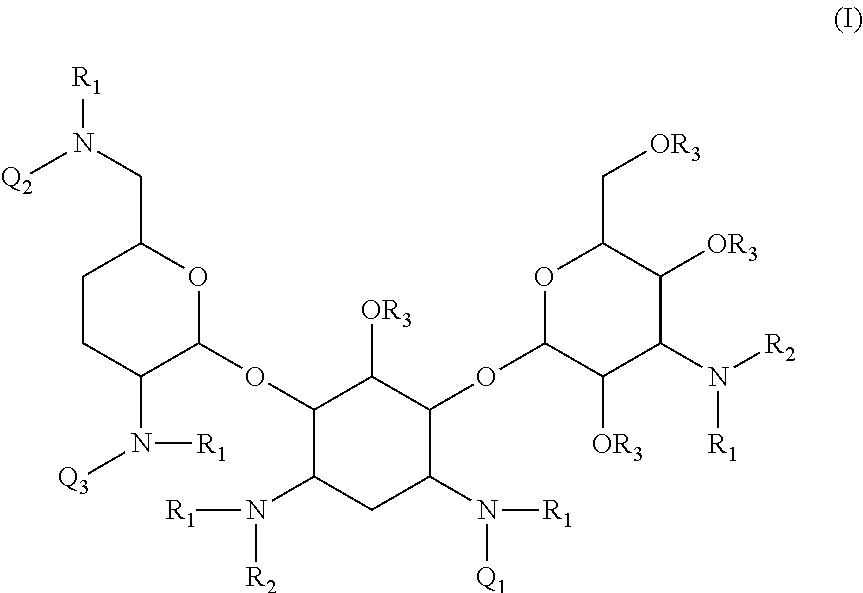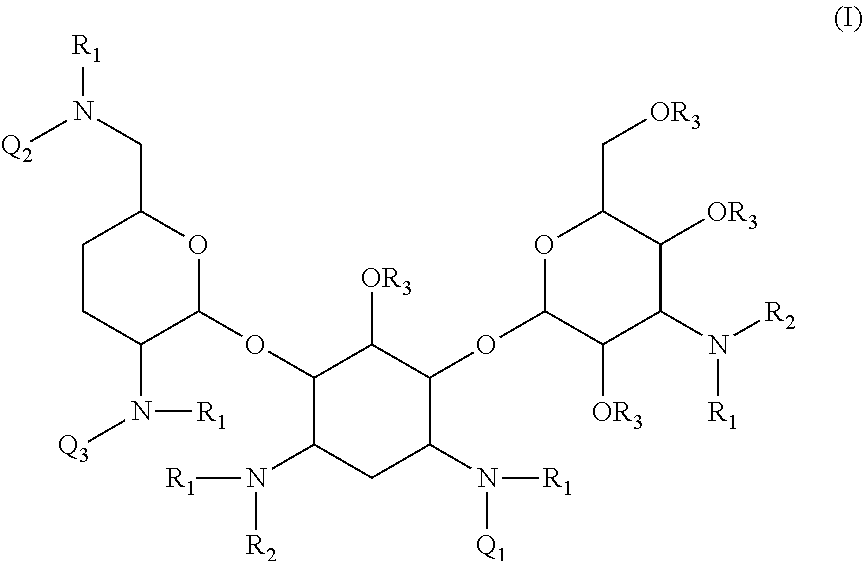Antibacterial aminoglycoside analogs
a technology of aminoglycosides and aminoglycosides, which is applied in the field of new aminoglycoside compounds, can solve the problems of difficult purification of proteins, inability to remove single alpha helix or beta sheet and use it in drug screening, and major limitation of classical high throughput screening of biologically active proteins
Active Publication Date: 2012-05-31
CIPLA USA INC
View PDF1 Cites 22 Cited by
- Summary
- Abstract
- Description
- Claims
- Application Information
AI Technical Summary
Problems solved by technology
Proteins can be extremely difficult to isolate and purify in the appropriate form for use in assays for drug screening.
The notion of removing a single alpha helix or turn of a beta sheet and using it in a drug screen is not practical, since only the intact protein may have the appropriate 3-dimensional shape for drug binding.
Preparation of biologically active proteins for screening is a major limitation in classical high throughput screening.
Quite often the limiting reagent in high throughput screening efforts is a biologically active form of a protein which can also be quite expensive.
Despite the central role RNA plays in the replication of bacteria, drugs that target these pivotal RNA sites of these pathogens are scarce.
Binding of aminoglycosides to this RNA target interferes with the fidelity of mRNA translation and results in miscoding and truncation, leading ultimately to bacterial cell death (see Alper, P. B.; Hendrix, M.; Sears, P.; Wong, C., J. Am. Chem. Soc., 1998, 120, 1965).
Perhaps the biggest challenge in discovering RNA-binding antibacterial drugs is identifying vital structures common to bacteria that can be disabled by small molecule drug binding.
A challenge in targeting RNA with small molecules is to develop a chemical strategy which recognizes specific shapes of RNA.
Misreading of the code during translation of integral membrane proteins is thought to produce abnormal proteins that compromise the barrier properties of the bacterial membrane.
Antibiotics are chemical substances produced by various species of microorganisms (bacteria, fungi, actinomycetes) that suppress the growth of other microorganisms and may eventually destroy them.
At the same time, these pharmaceutical agents have become among the most misused of those available to the practicing physician.
Many of these agents have also contributed significantly to the rising costs of medical care.
Unfortunately, this spectrum of activity can subsequently change to a remarkable degree, because microorganisms have evolved the array of ingenious alterations discussed above that allow them to survive in the presence of antibiotics.
Method used
the structure of the environmentally friendly knitted fabric provided by the present invention; figure 2 Flow chart of the yarn wrapping machine for environmentally friendly knitted fabrics and storage devices; image 3 Is the parameter map of the yarn covering machine
View moreImage
Smart Image Click on the blue labels to locate them in the text.
Smart ImageViewing Examples
Examples
Experimental program
Comparison scheme
Effect test
example 1
[0177]
example 2
[0178]
example 3
[0179]
the structure of the environmentally friendly knitted fabric provided by the present invention; figure 2 Flow chart of the yarn wrapping machine for environmentally friendly knitted fabrics and storage devices; image 3 Is the parameter map of the yarn covering machine
Login to View More PUM
| Property | Measurement | Unit |
|---|---|---|
| watts power | aaaaa | aaaaa |
| pH | aaaaa | aaaaa |
| temperature | aaaaa | aaaaa |
Login to View More
Abstract
Compounds having antibacterial activity are disclosed. The compounds have the following structure (I):including stereoisomers, pharmaceutically acceptable salts and prodrugs thereof, wherein Q1, Q2, Q3, R1, R2 or R3 are as defined herein. Methods associated with preparation and use of such compounds, as well as pharmaceutical compositions comprising such compounds, are also disclosed.
Description
CROSS-REFERENCE TO RELATED APPLICATIONS[0001]This application is a continuation of International PCT Application No. PCT / US2010 / 034886, filed May 14, 2010, now pending, which claims the benefit under 35 U.S.C. §119(e) of U.S. Provisional Patent Application No. 61 / 178,814 filed May 15, 2009 and U.S. Provisional Patent Application No. 61 / 312,351 filed Mar. 10, 2010. The foregoing applications are incorporated herein by reference in their entireties.BACKGROUND[0002]1. Field[0003]The present invention is directed to novel aminoglycoside compounds, more specifically, novel dibekacin derivatives, and methods for their preparation and use as therapeutic or prophylactic agents.[0004]2. Description of the Related Art[0005]A particular interest in modern drug discovery is the development of novel low molecular weight drugs that work by binding to RNA. RNA, which serves as a messenger between DNA and proteins, was thought to be an entirely flexible molecule without significant structural compl...
Claims
the structure of the environmentally friendly knitted fabric provided by the present invention; figure 2 Flow chart of the yarn wrapping machine for environmentally friendly knitted fabrics and storage devices; image 3 Is the parameter map of the yarn covering machine
Login to View More Application Information
Patent Timeline
 Login to View More
Login to View More Patent Type & Authority Applications(United States)
IPC IPC(8): A61K31/7036A61P31/04A61K31/7052C07H15/234C07H17/02
CPCC07H15/234A61K31/7036A61P31/04
Inventor GOLDBLUM, ADAM AARONDOZZO, PAOLAAGGEN, JAMES BRADLEYLINSELL, MARTIN SHERINGHAM
Owner CIPLA USA INC
Features
- R&D
- Intellectual Property
- Life Sciences
- Materials
- Tech Scout
Why Patsnap Eureka
- Unparalleled Data Quality
- Higher Quality Content
- 60% Fewer Hallucinations
Social media
Patsnap Eureka Blog
Learn More Browse by: Latest US Patents, China's latest patents, Technical Efficacy Thesaurus, Application Domain, Technology Topic, Popular Technical Reports.
© 2025 PatSnap. All rights reserved.Legal|Privacy policy|Modern Slavery Act Transparency Statement|Sitemap|About US| Contact US: help@patsnap.com



